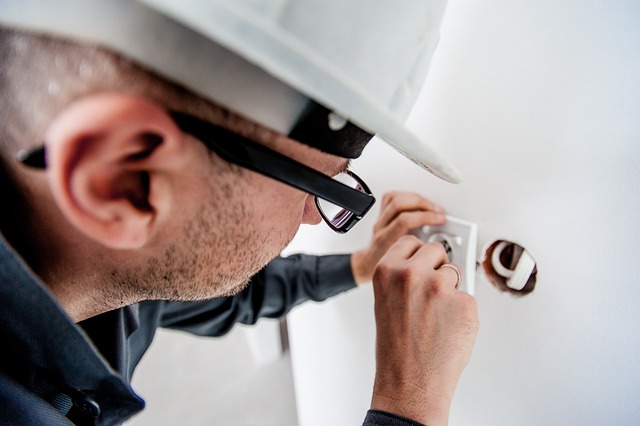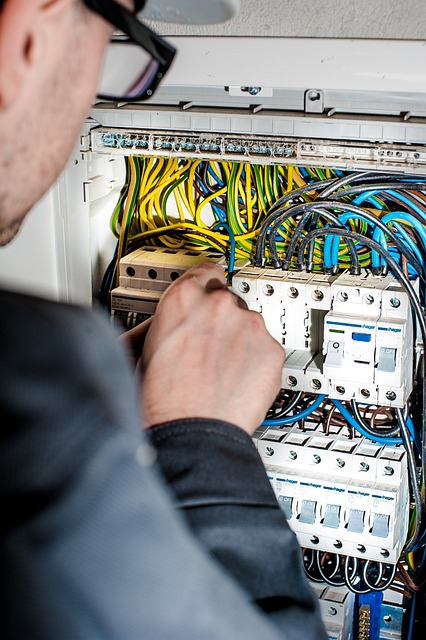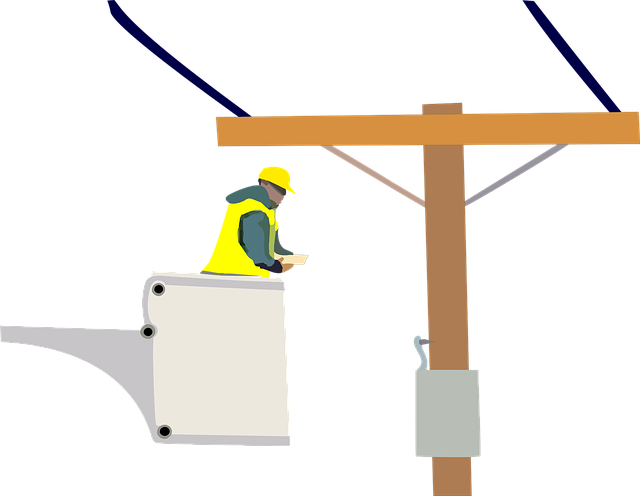Electrical inspectors play a crucial role in ensuring public safety and adherence to electrical codes through diligent plan reviews and on-site inspections at various stages of construction. They work closely with electricians, architects, and builders to identify potential hazards like overloaded circuits or poor grounding, which could lead to electrical fires or shocks, and provide solutions for compliance issues. Upon completion of a project, they issue certificates of compliance or occupancy approvals, which are essential for the safe and legal operation of buildings. Regular inspections by certified electricians are vital for detecting safety risks in residential, commercial, and industrial buildings, ensuring that aging infrastructure and new additions comply with stringent safety standards and building codes. Electrical systems inspections include checking service panels, outlets, wiring, lighting fixtures, switches, receptacles, and the functioning of circuit breakers and ground fault interrupters. Electricians also implement updates from authoritative bodies like the National Electrical Code (NEC), which incorporate new safety standards and technologies, ensuring that all electrical installations are safe, up-to-date, and in line with current regulations. This ongoing process of code updates and inspections is essential for maintaining high safety and energy efficiency standards within our built environment.
When it comes to safeguarding structures against electrical risks, the pivotal role of building inspections cannot be overstated. This article delves into the critical domain of electrical inspections, highlighting the expertise of electrical inspectors who vigilantly ensure adherence to building codes for safety and compliance. We will explore the key components that these professionals scrutinize during inspections, identify common hazards, and elucidate the dynamic process behind electrical code updates—all integral aspects that electricians and safety enthusiasts must understand. Join us as we shed light on the essential practices that protect our buildings from potential electrical perils.
- Understanding the Role of Electrical Inspectors in Ensuring Building Code Compliance
- The Importance of Regular Electrical Inspections for Safety and Compliance
- Key Electrical Components to Check During a Building Inspection
- Identifying Potential Hazards: Electrical Safety Risks in Buildings
- The Process of Electrical Code Updates and How They Affect Inspections
Understanding the Role of Electrical Inspectors in Ensuring Building Code Compliance

Electrical inspectors play a pivotal role in ensuring that buildings adhere to established electrical codes, which are designed to protect public safety and maintain consistent standards across the industry. These professionals review building plans and specifications prior to construction, verifying that all proposed electrical systems comply with national and local electrical codes. They also conduct on-site inspections during various stages of construction and after completion to ensure that installed electrical components meet code requirements. Their expertise is crucial in identifying potential safety risks, such as overloaded circuits or improper grounding, which could lead to electrical fires or shocks.
During the inspection process, electrical inspectors work closely with electricians, architects, and builders to address any non-compliance issues. They provide guidance on necessary corrections and ensure that all modifications meet code specifications. Post-construction, these inspectors perform a final evaluation before issuing a certificate of compliance or an approval for occupancy. This certification is vital for the safe operation of the building and for the legal acceptance of the construction project. The role of electrical inspectors thus underscores the importance of professional electricians who design, install, and maintain electrical systems in full compliance with these codes. Their diligence contributes significantly to the safety and functionality of our built environment.
The Importance of Regular Electrical Inspections for Safety and Compliance

Regular electrical inspections conducted by skilled electricians are indispensable for maintaining the safety and integrity of residential, commercial, and industrial buildings. These inspections serve as a proactive measure to identify potential hazards that could lead to electrical fires, equipment failure, or shocks. Over time, electrical systems can deteriorate due to factors such as wear and tear, outdated technology, or the addition of new appliances and devices. An electrician meticulously examines the entire electrical infrastructure, including wiring, circuit breakers, outlets, and grounding systems, to ensure they adhere to the latest safety standards and building codes. This due diligence not only prevents accidents but also ensures that the property remains in compliance with local regulations, thereby safeguarding the well-being of its occupants and the integrity of the structure itself. By enlisting a professional electrician for regular inspections, property owners can rest assured that their premises are safe and up to code, mitigating risks and avoiding potential legal issues related to non-compliance.
Key Electrical Components to Check During a Building Inspection

When an electrician conducts a building inspection with a focus on electrical systems, certain key components are critical to assess for compliance with safety standards and code requirements. The main service panel is a focal point during the inspection; it serves as the heart of a building’s electrical system. Here, the electrician will check for proper labeling of circuit breakers or fuses, ensuring that each one corresponds correctly to the respective circuits it protects. They will also verify that all connections are secure and that the panel has adequate capacity to handle the building’s electrical load.
Moving beyond the service panel, the electrician will inspect various other components. Outlets throughout the building must be functional, with proper ground-fault protection where necessary, such as in kitchens and bathrooms. The condition of wiring within walls is also a priority; any exposed or damaged wires that pose a fire hazard or electrical shock risk must be identified and addressed. Additionally, the electrician will examine all lighting fixtures, switches, and receptacles to ensure they are operating correctly and that there are no signs of overheating or wear that could compromise safety. Circuit breakers and ground fault interrupters should trip or reset as intended, demonstrating their functionality in protecting against electrical surges and overloads. Overall, the electrician’s thorough inspection of these key electrical components is essential for maintaining the safety and integrity of a building’s electrical system.
Identifying Potential Hazards: Electrical Safety Risks in Buildings

When assessing buildings for code compliance and safety risks, electricians play a pivotal role in identifying potential hazards related to electrical systems. These professionals are trained to inspect wiring, panels, and circuits to ensure they meet the current electrical codes and standards. A critical aspect of their work is the detection of overloaded circuits, which can lead to fire hazards or electrical failures. They check for proper grounding and the presence of appropriate safety devices like circuit breakers and GFCI outlets in areas prone to moisture, such as bathrooms and kitchens. Additionally, they examine the condition of all visible wiring, looking for signs of wear, corrosion, or damage that could compromise the integrity of the electrical system. Regular maintenance by qualified electricians is essential to mitigate the risks associated with outdated electrical systems in older buildings, which may not comply with modern safety standards. By conducting thorough inspections and making necessary upgrades or repairs, electricians help prevent electrical fires, reduce the risk of shocks, and ensure the safe operation of electrical devices within residential and commercial structures. Regular compliance checks by certified professionals are a key defense against potential electrical dangers in buildings.
The Process of Electrical Code Updates and How They Affect Inspections

Electrical code updates are a critical component in maintaining the safety and efficiency of buildings. These codes, which are periodically revised by authoritative bodies such as the National Electrical Code (NEC), reflect advancements in technology, materials, and safety standards. Electricians play a pivotal role in this process, staying abreast of these updates to ensure that their work adheres to the latest regulations. The update cycle typically involves a review process where experts evaluate new research, industry feedback, and technological innovations. Once updated, these codes necessitate that all existing and new electrical installations comply with the revised standards. For electricians, this means adapting their practices to align with these changes, which can range from the installation of new wiring methods to the implementation of advanced safety features. Building inspectors are tasked with verifying that these updates have been integrated correctly during building inspections. Their meticulous checks ensure that electrical systems meet the current codes, thereby safeguarding occupants and properties against potential hazards posed by outdated or non-compliant wiring. The integration of these code updates into existing structures can sometimes require significant modifications, highlighting the importance of electricians’ expertise and the dynamic nature of their profession. In turn, inspectors must be well-versed in the latest codes to accurately assess compliance, which involves a thorough understanding of both the theoretical aspects of electrical systems and practical application in various settings. This ongoing process of code updates and inspections is essential for the continuous improvement of building safety and energy efficiency standards.
buildings must adhere to stringent electrical codes to ensure safety and compliance, a task pivotal for certified electricians who serve as vigilant inspectors. Regular electrical inspections, which encompass scrutinizing crucial components like wiring, outlets, and grounding systems, are indispensable for identifying and mitigating potential hazards. As codes evolve to reflect advancements in technology and safety standards, electricians play a critical role in implementing these updates, safeguarding structures against electrical perils. Homeowners and facility managers must recognize the importance of these professional evaluations to maintain the integrity of their buildings. Enlisting skilled electricians for compliance checks is not just a protocol but a protective measure that upholds the safety and functionality of our living and working spaces.
